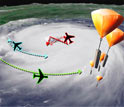News Release 05-162
Number of Category 4 and 5 Hurricanes Has Doubled Over the Past 35 Years
Sea-surface temperatures are also on the rise

New Orleans houses are swamped by floodwaters after Hurricane Katrina.
September 15, 2005
This material is available primarily for archival purposes. Telephone numbers or other contact information may be out of date; please see current contact information at media contacts.
The number of Category 4 and 5 hurricanes worldwide has nearly doubled over the past 35 years, according to a study by researchers at the Georgia Institute of Technology and the National Center for Atmospheric Research (NCAR). The change occurred as global sea-surface temperatures have increased over the same period.Atmospheric scientist Peter Webster of Georgia Tech's School of Earth and Atmospheric Sciences, along with scientists Greg Holland of NCAR and Judith Curry and Hai-Ru Chang of Georgia Tech, studied the number, duration and intensity of hurricanes worldwide from 1970 to 2004.
Results of the research will appear in the Sept. 16 issue of the journal Science.
"Basic physical reasoning and climate model simulations and projections motivated this study," said Jay Fein, director of the National Science Foundaton's (NSF) climate and large-scale dynamics program, which funded the research. "The results will stimulate further research into the complex natural and human-caused processes influencing tropical hurricane trends and characteristics," he said.
"What we found was rather astonishing," said Georgia Tech's Webster. "In the 1970s, there was an average of about 10 Category 4 and 5 hurricanes per year globally. Since 1990, the number of Category 4 and 5 hurricanes has almost doubled, averaging 18 per year globally."
Category 4 hurricanes have sustained winds from 131 to 155 miles per hour (mph); Category 5 systems, such as Hurricane Katrina at its peak over the Gulf of Mexico, pack winds of 156 mph or more.
"Category 4 and 5 storms are also making up a larger share of the total number of hurricanes," said Curry. "These hurricanes made up about 20 percent of all hurricanes in the 1970s, but over the past decade they accounted for about 35 percent."
The largest increases in the number of intense hurricanes occurred in the North Pacific, Southwest Pacific and the North and South Indian Oceans, with slightly smaller increases in the North Atlantic Ocean.
This trend is happening, the scientists say, as sea-surface temperatures around the globe are rising--anywhere from 0.50 to 1.0 degree Fahrenheit, depending on the region--over hurricane seasons since the 1970s.
The North Atlantic averaged eight to nine hurricanes each year in the past decade, compared to the six to seven before. Category 4 and 5 hurricanes in the North Atlantic have increased at an even faster clip: from 16 between 1975 and 1989 to 25 between 1990 and 2004. That constitutes a 56 percent increase.
Research published in July in the journal Nature and also funded by NSF reached a similar conclusion. In that issue, scientist Kerry Emanuel of the Massachusetts Institute of Technology reported finding an increase in the duration and power of North Atlantic and North Pacific hurricanes.
Whether such increases are due to human-induced global warming is still uncertain, said Georgia Tech's Webster. "We need a longer data record of hurricane statistics, and we need to understand more about the role hurricanes play in regulating the heat balance and circulation in the atmosphere and oceans."
Webster is working to determine the role of hurricanes in regulating Earth's climate. "The thing they do more than anything is cool the oceans by evaporating the water and then redistributing the oceans' tropical heat to higher latitudes," he said. "But we don't know a lot about how evaporation from the oceans' surface works when the winds get up to around 100 miles per hour, as they do in hurricanes."
Webster adds that this understanding is crucial to connecting trends in hurricane intensity to overall climate change.
"If we can understand why the world sees about 85 named storms a year and not 25 or 200, for example, then we might be able to say it is consistent with a global warming scenario. Without that understanding, a forecast of the number and intensity of tropical storms in a future warmer world would be statistical extrapolation."
-NSF-
-
Debris is scattered on the beach in Biloxi, Miss., after Hurricane Katrina.
Credit and Larger Version -
NSF supports the RAINEX program to better understand hurricane intensity.
Credit and Larger Version
Media Contacts
Cheryl Dybas, NSF, (703) 292-7734, email: cdybas@nsf.gov
David Terraso, Ga. Tech., (404) 385-2966, email: david.terraso@icpa.gatech.edu
Anatta , UCAR/NCAR, (303) 497-8604, email: anatta@ucar.edu
Related Websites
Scientists Fly Into Hurricane Katrina's Eye: www.nsf.gov/news/news_summ.jsp?cntn_id=104386&org=olpa&from=news
Hurricanes Growing More Fierce Over Past 30 Years: www.nsf.gov/news/news_summ.jsp?cntn_id=104325&org=NSF&from=news
Rainbands Offer Better Forecasts of Hurricane Intensity: www.nsf.gov/news/news_summ.jsp?cntn_id=104329&org=NSF&from=news
The U.S. National Science Foundation propels the nation forward by advancing fundamental research in all fields of science and engineering. NSF supports research and people by providing facilities, instruments and funding to support their ingenuity and sustain the U.S. as a global leader in research and innovation. With a fiscal year 2023 budget of $9.5 billion, NSF funds reach all 50 states through grants to nearly 2,000 colleges, universities and institutions. Each year, NSF receives more than 40,000 competitive proposals and makes about 11,000 new awards. Those awards include support for cooperative research with industry, Arctic and Antarctic research and operations, and U.S. participation in international scientific efforts.
Connect with us online
NSF website: nsf.gov
NSF News: nsf.gov/news
For News Media: nsf.gov/news/newsroom
Statistics: nsf.gov/statistics/
Awards database: nsf.gov/awardsearch/
Follow us on social
Twitter: twitter.com/NSF
Facebook: facebook.com/US.NSF
Instagram: instagram.com/nsfgov


